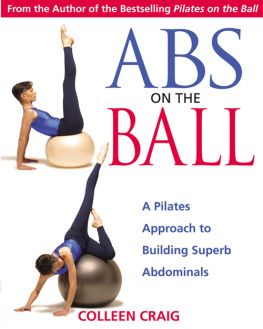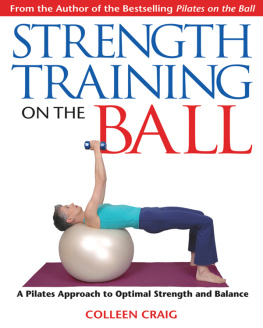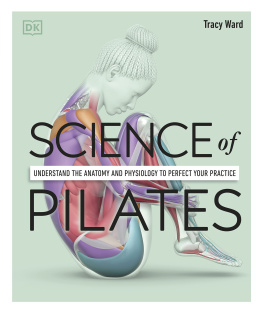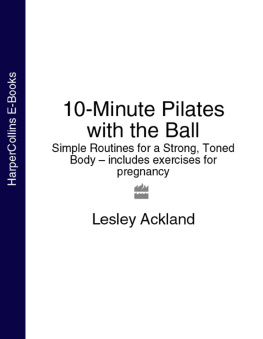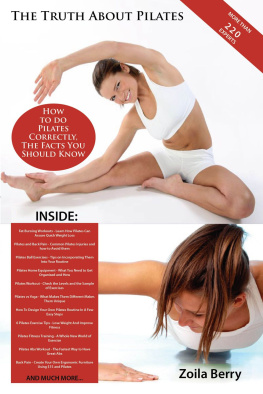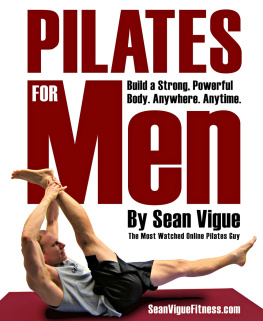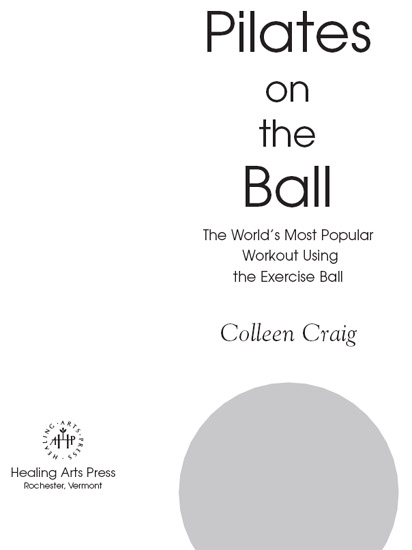
Acknowledgments
I would like to thank my parents, Lorraine and David Craig, and my sister, Jane Welch, for their love and invaluable support. Thanks to my nieces Lyndsey and Lauren, who worked tirelessly with me on the ball, allowing me to learn much from their young, elastic bodies.
Many, many thanks to Laurie Colbert and Dominque Cardona for voluntarily stepping forward to film my video, On the Ball. I am grateful to Craig Rose and Marie Jover-Stapinski for appearing with me in the tape and in the book. Thanks also to Claire Letemendia for her editing skills and for cheering me through the writing of the manuscript; Maureen Dwight for her feedback as a physical therapist; Ingrid MacDonald for her sound business advice; David Hou for his wonderful photos and illustrations; and Judd Robbins for sharing his photos of Joseph Pilates. Heartfelt thanks to my editor at Healing Arts Press, Susan Davidson, for superbly editing the final manuscript and for calmly managing the endless details of this project. Thanks to Peri Champine for creating the wonderful cover, to Janet Jesso for doing a fine job with the initial copyediting, and to the rest of the design, production, and marketing team at Healing Arts Press.
I have had many teachers in my ongoing Pilates training, and it is a pleasure to acknowledge them here. I am grateful to Moira Stott for exposing me to and certifying me in Stott Pilates, her contemporary approach to the Pilates Method. I must thank the outstanding senior instructors who were at Stotts at the time of my training, especially Beth Evans, Miriane Braaf, Syl Klotz, Elaine Biagi-Turner, and Connie Di Salvo. In addition, there are those whose movement workshops or videos I have found invaluable: Danielle Belec, Tanya Crowell, Frank Bach, Karen Carlson, Joanne Posner-Mayer, Trish Scott, and Cheryl Soleway. I am indebted to Mari Naumovski for showing me her amazing BodySpheres Ballwork as well as reading the manuscript.
I am most grateful to my sponsors, who have supported my work financially and emotionally from the beginning: Dayna Gutru and all those at Ball Dynamics International and Donna Micallef and Constance Rennett at Know Your Body Best. I want to thank them for supplying the balls and for generously funding the artwork and photographs that appear in this book and on its cover. (Thanks to Constance also for reading the manuscript.)
Over the years there have been key people who believed in me and nurtured me as a writer. They are Robert Harlow, Florence Gibson, Emil Sher, Ingrid MacDonald, Kirsten Strand, Eliza Moore, Rose Scollard, Alexandria Patience, Phillip Kakaza, Edward Shalala, Wayne Morris, Marianne Thamm, Anne Mayne, Vida du Plessis, Helena Scheffler, Christell Stander, and Freddie van Staden. Perhaps most of all I would like to acknowledge Lynne Viola for her emotional support over the years, her expert editorial guidance and career advice, and for taking me with her to wonderful destinations around the world. Also thanks to Monty.
Because I believe that Pilates on the Ball is beneficial to the mind/body as well as the soul, many of my chapter epigraphs are from a book that stresses mind, body, and soul health: Simple Abundance by Sarah Ban Breathnach.
Finally, I am most grateful to the students and colleagues who allowed me to change their names and use their stories, or composites of their stories, throughout this book. I am blessed with the most loyal students in the world, and I send many, many thanks to all of you for teaching me new things every day.
Preface
Pilates on the Ball is amazing. It feels like exercising on a waterbed. Its a marvelous, cutting edge sort of thing.
Student evaluation, University of Toronto Exerball class
The first time I attended a ball classworking out with a large vinyl, air-filled ballit was at my local Y. I began the class full of energy and self-assurance. After all, you dont fight gravity lying horizontally on a mat. I dazzled myself with rolling and balancing, stretching and lunging, tossing the ball high into the air and catching it between my feet like a circus performer. Wow!
Halfway through the forty-minute class I was out of breath and out of steam. My eyes flitted from the clock to the instructors face: why was she torturing us? I surveyed the other participants. A couple of them were whining or smiling ironically at their own failings as they surrendered, exhausted, falling to the floor near their balls.
It was rare for me as a partaker in a mind/body class to be concerned with the other participants progress, but I had to assess how others were coping. Nothing in my physical past, not all the years of dance training, childhood gymnastics competitions, or extensive Pilates training, had quite prepared me for the astonishing vigors of ballwork. Every muscle in my body was alive: even my abdominals, which I believed to be rock hard, were groaning. After the forty-minute class I had planned to go to the weight room but could hardly drag a comb through my hair. Instead I collapsed into a chair in the Ys cafeteria and tried to understand what had happened.
I often boasted of being stronger in my mid-forties than I was in my mid-twenties. I claimed that Pilates had realigned and reshaped my body, heightened my mind/body awareness, and cultivated a deep core strength I never believed I possessed. Yet the ball had played havoc with the image I held of myself. During some exercises I had no idea what muscles to recruit in order to accomplish the balance and control needed. For the first time I understood the full significance of the word recruita word appropriated from military parlanceto describe the physical mobilization of muscles. This word had never meant anything to me in the context of movement classes, but now translated nicely to the challenge of ballwork.
At the same time that I was critically analyzing the ball, I was also savoring the bliss of the workout. Never before had I experienced such deep, comfortable stretches. I had lain backward over the ball and felt my spine become one with the shape of the sphere as the pull of gravity deliciously opened me up bone by bone. Never had I felt such an efficient, functional use of my body. I performed a series of arm exercises in which the entire torso was engaged, not only the arms and shoulders. And near the end of the workout, when we were allowed to drape our spent bodies over our balls and sink into a luscious pose that the instructor dubbed a little piece of heaven, I had a flash of womblike serenity, with breath as my only companion.
Soon after that fateful first experience I began to take serious stock of the group mat classes that I instructed each week based on the teachings of Joseph Pilates. In a traditional private Pilates session you usually work half the time on the mat and half on an apparatus. Joseph Pilates had designed specific pieces of equipment to add resistance to the matwork and to enhance stretching, both of which are key to an effective bone and muscle workout. Yet these pieces of equipment, found in exclusive Pilates studios around the world, are expensive and not at all portable. In a group situation you are restricted to the mat exercises. This has always seemed like a shortcoming to me. If only I could somehow integrate the ball into my group classes so that the user would get all the benefits of resistance and weight-bearing support right from the start. Moreover, the ball would expose mat students to the repertoire of equipment-based routines.
Exercise balls were not used in my Pilates training and are not part of the equipment associated with the Pilates Method. Yet I had the potential to create something new and to make all that was good about Pilates even more effective for my students. One by one I methodically went through all the mat and equipment-based exercises to determine which exercises the ball could enhance. Unlike the Y class with its grueling repetitions and aerobic emphasis, I tried to stay as close as possible to my extensive Pilates training and experience, remaining as faithful as I could to the science and principles of the method. When I began to share Pilates on the Ball with other Pilates teachers, physiotherapists, physical education teachers, and fitness editors, their overwhelming response confirmed what I already knewthat I was on to something good.
Next page

